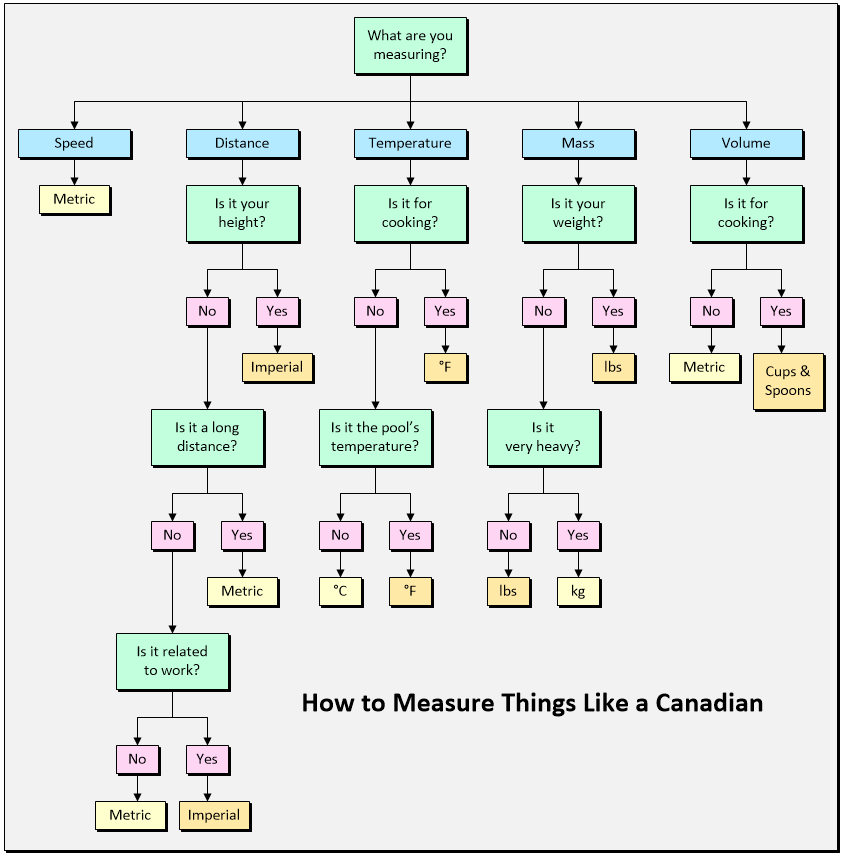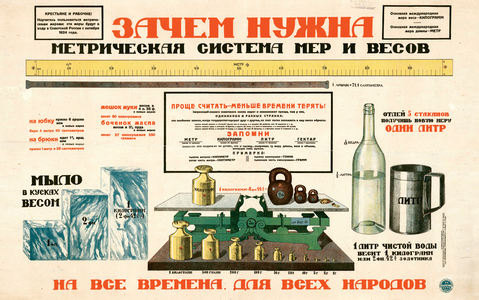The metric system is fine in a lab. But, in terms of basic human living the imperial system, which wasn’t designed so much as developed over years of usage, is simply superior. It works better and is generally more convenient and flexible.
[Citation needed]
You neef their ass?
Nah, what’re you talking about?
Case in point: whose foot?
The UK continues to use miles when discussing speed and distance. The road signs use imperial units.
I was born in northern England in the early 90s, and I can only eyeball in imperial units, even though I now live in a country where they only use metric (and Beaufort).
Look I get it, but also, I like fahrenheit and miles. They are more intuitive and closer to the ‘feeling’. 100 degrees is really hot. 100 mph is really fast. Maybe that’s my own bias from growing up with it though
I also find inches easier to work with unless I’m making something with my 3d printer. Fractions are just easier when you’re making something big with looser tolerances.
3 2/10 cm is easier than 3.2cm?
Doing things in 1/16ths of an inch is easier than metric for like woodworking and such IMO. Especially since most tools and materials come in inches here. Until you get into stuff that has tighter tolerances than 1/16th of an inch. Even then you could go to .010s or .001s of an inch but I’m more used to metric at that scale and that’s what the applications I use for 3d printing default to.
you don’t get it.
your tools and materials will come in metric when everything is metric.
doing things on 1/10 of an inch or 1/10 of a cm is the same as 0.1 inches or 0.1 cm.
1/16 = 0.0625
3/16 of an inch = 0.1875 inches
as in “1/16th” literally means “one divided by sixteen, so do extra math instead of just giving you the real number”
decimal doesn’t mean, nor have anything to do with metric.
So I have to throw out all my stuff and spend $1000s on new tools?
You don’t work in 1/10ths of an inch. It’s 1/16ths and that that’s where the math ends. You don’t need to convert it to decimal. Unless you’re doing machining which you do work in .0001ths due to the tighter tolerances and I’ve already agreed you might as well use metric for that.
you’re talking about two or three different, unrelated things.
- decimals vs fractions - you’re whining that 1/16 gives you more leeway, but too stupid to realise that 1/10 is less precise and is the same as 0.1
So either you’re happy with less precision - and decimals are good, or you want more precision - and decimals are still good.
Again - absolutely nothing to do with metric. You can convert 3 3/4 inches to 3.75 inches, 3 12/16ths or 3 7.5/10ths of an inch. They’re all the same thing and all imperial.
-
Tools. The topic is “using metric”. Once you have all metric tools, then it doesn’t matter. You’re trying to change the topic to buying new tools. Unrelated. Using a tool vs shopping like a princess for new toys. We’re talking about using tools.
-
but hey, while we’re on the topic of how dumb you are, let’s keep using what you say against you. You keep saying “it doesn’t have to be that accurate” well, okay then. then get a sharpie, write the approximate metric conversion on the side and get on with your life. A 5 minute job for someone who I presume can write numbers and count to ten?
-
I knew there were more. What you don’t get, what you keep missing, is that 1/16 is smaller than 1/10. that means your bitching about “tighter tolerances” applies more to dicking about with 1/16ths instead of 1/10s (which again, is decimals, nothing to do with metric)
If you can’t have a civil conversation without insults I’m not going to bother with you anymore. We’re talking about units of measurement, there’s no reason to be an asshole. Go fuck yourself.
you don’t get it. […] decimal doesn’t mean[…]
No, you’re not getting it. 1/16 isn’t a function of a decimal system. It’s base 2. Primarily because you don’t really deal with 1/10th of something, but half of a half sort of stuff.
1/2, 1/4, 1/8, 1/16…
2-1, 2-2, 2-3, 2-4…
And base-2 functions make sense in wood working in general because of it’s imprecise nature. It’s more useful to compare things in halves. A 2x2 piece of wood is not literally 2inches x 2inches. Even in Europe you guys follow weird numbers for finished wood dimensions. It doesn’t make sense to have such precision when nothing about it is precise.
1/16 of an inch is slightly smaller than a millimeter, you’d just end up using a millimeter or half again as your tolerance limit.
The big issue with imperial is all the fractions and strange conversions. On more then one occasion I’ve caught myself mixing up eighths and quarters, because my brain views them more as concepts then as numbers. Which is bigger, 11/16 or 3/4? Now, you’ll get the answer, sure, but you had to think about it and it goes against the natural intuition that larger numbers are bigger. Compare that with, which is bigger 0.6875 or 0.75 and it should be trivial to see which is easier to learn and use.
0.6875 is basically a meaningless concept to me when I try to picture it in my head and what if you need to add it to another dimension? It’s not easy to work 4 decimal places in your head. .75 only works because I automatically convert it to 3/4. Maybe it’s just something that comes with experience but I don’t have trouble with knowing what’s what. If your not sure you can always make the denominator equal and figure it that way. 3/4=12/16 for instance. Easy math to do in your head.
Sure, but your measuring system dictates what lengths you actually design things to be. You would never actually use 0.6875, but if some jerk designed something with that length, it will be easy to tell exactly how big it was. If you switched to metric, your smallest practical unit for woodworking would almost certainly be a millimeter.
The problem is everything is already built using the imperial measurements. Even if we switched all the new tools and materials over to metric we’d be stuck having to do a bunch of conversions when we’re integrating it into existing construction and we’d probably be dealing with that for the rest of our lives.
Yeah, I think it’s mostly just a familiarity thing. To me 0°C is cold af, 10°C is chilly, 20°C is nice and 30°C is hot. 100 km/h is fast but not really fast, though I’m probably biased in this regard from regularly driving on the Autobahn lol
Out of curiosity, what would you consider “too cold to go out”? Not really about the metric/celcius system, but 0c is light jacket weather for me.
The temperatures are intuitive for me because Celsius is all I’ve known. The car going 60km/h or 100km/ h I know the difference and how it feels sitting in the car. The speed of wind in the forecast needs to be m/s to make any sense. Over 20 m/s I better tape the windows so that the storm won’t break them
exactly! whenever anyone says imperial units are “more intuitive” and better reflect “how it feels to humans”, i can only think: obviously, you grew up with it. that’s what you know.
no matter what measurement system you were raised on, it will feel intuitive to you and reflect how you as a human experience the world because you are used to measuring things in those units. having said that, i’d much rather we used metric if for nothing else than the ease of unit conversion.
When it comes to Fahrenheit, there is some merit to the idea - 0 to 30 is a small scale compared to 0 to 100, and unlike Imperial vs. Metric, Celcius has no base 10 system that makes any more sense than Fahrenheit does. . The opposite is true of kilometers and miles - kilometers is more refined since each unit is a shorter distance.
I’d prefer the Metric system, but Farenheit over Celcius for temperature measurement.
The fixed points (for 0 and 100) are much more logical though and can be used to accurately recreate the scale anywhere (well… it’ll be slightly off on higher altitude since boiling temperature changes but it’s still not far off).
0°C = water freezes (= it’s snowing)
100°C = water boils
meanwhile:
0°F = the coldest night Mr Fahrenheit experienced, thinking it couldn’t get any colder than that
100°F = Mr Fahrenheit’s own body temperature (he had a slight fever apparently)
How would you recreate that??
I am not water.
The temperature of water boiling is not a useful metric when it comes to the weather, as it’s extremely far outside of where humans can live. Science uses Celcius standard, and that seems to work fine, but I see no reason why we should use it for the weather.
The temperature of ice melting, on the other hand, is hugely important for weather. 0 point is placed at a very important spot as far as weather observations go.
Can’t say that of Fahrenheit.
We’ll just keep things as they are becuase it seems to be working fine.
I think we can agree that the freezing point is super important when it comes to the weather.
So where would you place the second mark (you have to define two spots) so it “makes sense for the weather” (I don’t see how it makes less sense for the weather than Fahrenheit, at least Celsius tells you if it’ll snow or not while Fahrenheit tells you nothing) while still making sure that it can easily be recreated?
That’s an artefact of the “now”.
In Australia we once had the imperial system and about a year after the big switch (14 Feb 1966) we became all metric like a mofo. Now 35c feels hot and 15c feels cold. Plus units of ten is so much easier than factions.
Ask the US military about the metric system, they’ve been using it since at least Vietnam, if not earlier.
As an army vet. No we don’t. Never once in the military did I use Celsius. For distances we used both. I have pictures from inside my vehicles where the speedo was in miles.
Not only is 100C is also really hot, it’s the boiling point of water. Now that’s a 100 degrees that really stands for something.
“intuitive” in the sense you described just means “familiar”. One feels like one. Ten feels like ten.
The magic of metric isn’t that each base unit is somehow more valuable in metric. It isn’t. One will always feel like one.
The magic is how easy it is to convert from the “small one”, the “medium one” and the “big one”.
Also, the convention of fractional inches is ridiculous.
It should be trivial to order 27/64, 3/8, and 7/16. Don’t make me do that math.
Hard disagree on the fractional units. Using rational numbers for those things derives from the frequency with which people need to double and halve things in the fields that use those conventions. Doubling 3/8 to get 6/8 or 3/4 is much easier than doubling .375 to get .75
That one’s nothing to do with the metric system vs imperial, aside from the fields that rely on the convention being largely the ones that created imperial in the first place. If they all switched to metric tomorrow they’d just say they need 3/5 meter spacing.
Does Germany use 3/5m spacing?
I looked it up and they use 2/5 meter spacing. Some other countries nearby use 3/5th though.
And it’s described locally as 2/5 and 3/5, rather than 40 or 60 cm?
If so, I’m shocked, but delighted to have learned something unexpected
From everything I’ve heard it’s a hodge podge, since the US, with the worst system, is the only one to use it consistently. Building plans would reference it by cm however.
What I was more referring to was from the perspective of the carpenter doing the work.
Fractions or decimals aren’t specific to us customary or metric. You see decimal inches perfectly often, or at least I do.
Fractions are a more convenient way of dealing with multiplying or dividing numbers without a lot of mental effort. 1/3 of .125 is gonna take a second to figure out. 1/3 of 1/8 is 1/24. 5 1/8 units is just ”5/8”, rather than the .625 in decimal.
It’s definitely less effective for numerical sorting in your head, but if I’m sorting screws or something, I’m probably gonna just look at them rather than compare the labels.I understand the underlying principle, but I’m not sure if it actually shakes out that way for a few reasons:
If you asked a carpenter to cut something to 1/24", they’d be like “what?”. Sure, the math was easier, but the result is unusable. No measuring instrument has divisions of 24ths. The person making a cut would need it in terms of 8ths, 16ths, etc. Any time saved at the initial stage is lost when they need to convert it again to a useable denominator.
Secondly, what’s 3/32nds of 17/128ths?
The examples you give are harder in decimal form because nobody is going to make metric carpentry designs for things that are to the tenth of a millimeter, so 1.25cm isn’t even real.
I admit, there are a lot of specific scenarios where fractional convention is helpful. I just personally think they don’t outweigh the drawbacks.
I feel the same way about Fahrenheit, but boy do people hate it when you say it out loud.
I’ve never had to use Kilometers much but I’m sure I wouldn’t have much trouble adapting to that as much.
Yeah, and the benefits of switching does not out weigh the costs, like redoing all the signage and re-educating everyone and inevitable higher accident rate.
How would you even measure “They are more intuitive and closer to the ‘feeling’”. It’s not. You’re used to it. No one else in the world that grew up with C is going to find F more intuitive. Neither miles.
I’m a European living in the UK for 9 years. I still don’t know what a mile is. There’s nothing intuitive about Imperial units, you’re just used to them.
Be the change you want to see in the world. Use the metric system.
I’m a machinist, I don’t get to choose my units. We use standard and try to avoid metric dimensioning like the plague. The difference between .005 inches and .005 millimeters is literally an order of magnitude.
I did it all the time. But I’m not american.
Here is an alternative Piped link(s):
https://piped.video/JYqfVE-fykk
Piped is a privacy-respecting open-source alternative frontend to YouTube.
I’m open-source; check me out at GitHub.
Fine, fine, Ill use celsius.
“Fuck me it’s hot today”
“Yeah it’s at least four washing machines Celsius bro”
We have it in Canada. Do you want to borrow ours?
The reality is that the US uses the metric system but everything is translated into freedom units for the general population. Another situation where you believe against all evidence that you have something that you really don’t have.
Are you under the impression that Canada doesn’t use imperial measurements for anything?
You were so sure you got me. Sorrry.

I didn’t realize Canadians measured things in 240p

Seriously I’m not sure if you messed something up or if Lemmy is messing up but I can’t read any of that text other than the title
Good news, everyone!
There is no text.
Top text: Why metric system is needed
Middle text is mostly blurred, but “easier to count - less time to waste” is seen.
Bottom text: for all times and for all people

If we switched to metric, everything we currently have built will suddenly have weird measurements. I don’t want my 10 foot even high ceiling to be 3.048 meters. 😩 /s
Yep, this is why all the buildings spontaneously exploded in places that changed to metric. /s
Things get phased out. Certain buildings will adhere to old code and new ones would adhere to new codes in metric.
I’m a scientist. I’ve used the metric system since grade school. In fact, I convert Imperial measurements to metric to do estimates.
Engineer here, I just use whatever’s convenient. It’s handy to know both.
That said, I did confuse a poor coworker of mine this week when I was using bar for tank pressure and psi for the safety reliefs. That’s totally on me though.
and that’s why challenger blew up. or was that the hubble screw up?
It was a Mars lander.
I’m in favor of freedom, don’t force metric or customary on anyone. Let people measure things they way they want.
you must hate the towel of babel story in the bible.
Again, who’s gonna pay for the conversion? Sure we could switch like the Aussies did, but no one wants to pay for new shit when the shit that already exists serves its purpose well enough.
Get the financing, and then come back.
Just start doing it now and eventually things will have converted. It may take a while, but it will happen eventually if you do it consistently.
But there are too many contrarian Americans out there who’ll take inconvenience over logic just because it “the American way” or “America is special.” Have several of those people in my extended family.
just make all new things metric as the primary unit and US imperial as the secondary. eg. reverse the display on a speedometer
Seconding that. Slow phase is the way - as the old shit breaks, replace it with metric. Not just for cost, but to ease folks into it.
Who’s gonna pay for not converting (which is much more expensive)?
A few years ago I started using Celsius in my everyday life. It’s been pretty easy, just remember that C scales twice as fast as F, and 32F=0C and you’re set for conversations. It helps to be quick with math, but finding it difficult may make it easier to convince other people to use it instead of F near you. To acclimate yourself you’ll want to change the settings on your phone to use C by default.
I haven’t switched over to m in everyday use, because all the roadsigns are in Mph and doing that conversion while driving is bad juju.
I’m thinking of rewriting all my recepies in grams and liters. If I can figure out how to get our stupidly-over-designed-yet-entirely-jank oven to use C, that’d be good too. If we had one with a bimetalic strip and a knob I’d be able to just print one with the new temperature scale.
Honestly, temperature (in terms of weather preparedness, not cooking) makes WAY more sense with Fahrenheit. Largely the only temperatures you care about are 0 to 100 and generally you feel a good difference in temp every 10 degrees F.
Almost everything else I prefer metric. But that’s one where Celsius is just terrible.
The reason you feel that way is because you’re used to it.
Similarly, Celsius feels natural to me, as I’ve lived with it all my life.
That’s a poor argument, though, when the justification for utilizing volume, mass, and distance is because it is very “base 10”-y and is easily divisible and understood.
Celsius absolutely is shit for that.
I could use your logic to justify why imperial units are better for length, for example, but we all know it’s a bit fucked. Celsius is absolutely fucked for temperature regarding human comfort and is imprecise.
Replying again because you’ve edited your comment and added another paragraph.
Your edit asserts that Celsius is “absolutely fucked” regarding temperature for human comfort… which is an utterly bizarre argument to make because it only makes sense to people who are used to Fahrenheit and have an intuitive sense of what 72F means to them, but have no intuitive sense of what 22C means
I’m not entirely sure that you’re not just trolling now.
No negative numbers needed for most cases, 0-100 scale for the extremes MOST people need to care about with relative “feels like” every 10 degrees (but realistically every 5 is distinguishable, even smaller amounts depending). Ez pz.
IDK why you’re so defensive about Celsius lol. It’s okay to admit when an SI unit has a poor application. Your ONLY defense for it is “well people can get used to it” which is the exact same reason I could say “well you could just get used to feet, inches, yards, miles, pounds, ounces, fluid ounces, teaspoons, tablespoons, etc” - it’s a shit argument for both.
But oh that’s right this is Lemmy where “america bad” for everything.
Right, so…once again, your argument is that you feel that Fahrenheit makes more sense, because that’s what you’re used to
I never said that C is better because people can get used to it, you’re just making that up. I said that the system people are used to is inherently going to be the one that makes the most intuitive sense to them, and that applies to both C and F.
The rest of what you said applies equally to any system of measurement.
I don’t understand why you’re so angry about this?
The entire point of this post under which we are all commenting is insinuating a superior system of measure. Jesus you actually are this stupid.
So… in your opinion, Celsius is shit because you’re not used to it ?
Tell me you didn’t read the argument without telling me you didn’t read the argument.
Ah yes, more insults. Your argument of ‘the system I use is better because I abuse people who disagree with me’ is very compelling indeed.
Saying that you didn’t read my argument because your point ignored it entirely is an insult? It’s abuse? LMAO.
Are you fucking stupid? <- that is an insult
no.
Brilliant response.
🤷♂️ it was as much as it deserved.
Could just admit you’re a stupid cunt and move along
oh, sweetie, no.
no.
Oh, honey, yeah.
Yeah.
Tread lightly my friend. I already won the Fahrenheit vs. Celsius debate a few months ago, but non-Americans are insanely defensive about the metric system and won’t accept the truth.
https://sh.itjust.works/comment/9757434
I’ll transcribe my best arguments because that thread was an absolute shitshow and it’s hard to find my comment even with the direct link. Almost all of my most downvoted comments on Lemmy came during my defense of the Fahrenheit temperature scale, and I’m weirdly proud of that fact.
Fahrenheit Supremacy Gang
Celsius is adequate because it’s based on water, and all life on earth is also based on water, so it’s not totally out of our wheelhouse. But for humans specifically I think Fahrenheit is the clear answer.
One point that many may overlook is that most of us here are relatively smart and educated. There are a good number of people on this planet who just aren’t very good with numbers. Obviously a genius could easily adapt their mind to Kelvin or whatever.
You have to use negative numbers more frequently with Celsius > Celsius has a less intuitive frame of reference
Each Celsius degree is nearly two Fahrenheit degrees > Celsius is less granular
The reason I argue the more granular Fahrenheit is more intuitive is because a one degree change should intuitively be quite minor. But since you only have like 40 or 50 degrees to describe the entire gamut of human experiences with Celsius, it blends together a bit too much. I know that people will say to use decimals, but its the same flaw as negative numbers. It’s simply unintuitive and cumbersome.
B) 66F is room temperature. Halfway between freezing (32F) and 100F.
the intuition is learned and not natural.
All scales have to be learned, obviously. It’s far easier to create intuitive anchorpoints in a 0-100 system than a -18 to 38 system. Thus, Fahrenheit is more intuitive for the average person.
I should note that if you are a scientist, the argument completely changes. If you are doing experiments and making calcualtions across a much wider range of temperatures, Celsius and Kelvin are much more intuitive. But we are talking about the average human experience, and for that situation, I maintain Fahrenheit supremacy
It’s not about the specific numbers, but the range that they cover. It’s about the relation of the scale to our lived experience. Hypothetically, if you wanted to design a temperature scale around our species, you would assign the range of 0-100 to the range that would be the most frequently utilized, because those are the shortest numbers. It’s not an absolute range, but the middle of a bell curve which covers 95% of practical scenarios that people encounter. It doesn’t make any sense to start that range at some arbitrary value like 1000 or -18.
When the temperature starts to go above the human body temperature, most humans cannot survive in those environments. Thus, they would have little reason to describe such a temperature. Celsius wastes many double digit numbers between 40-100 that are rarely used. Instead, it forces you to use more negative numbers.
This winter, many days were in the 10s and 20s where I live. Using Celsius would have been marginally more inconvenient in those scenarios, which happen every winter. This is yet another benefit of Fahrenheit, it has a set of base 10 divisions that can be easily communicated, allowing for a convenient level of uncertainty when describing a temperature.
Generally -40 to 40 are the extremes of livable areas.
Sure, water is a really good system and it works well.
And for F that range is -40 to 104. See how you get 64 extra degrees of precision and nearly all of them are double digit numbers? No downside.
Furthermore F can use its base 10 system to describe useful ranges of temperature such as the 20s, 60s, etc. So you have 144 degrees instead of just 80, and you also have the option to utilize a more broad 16 degree scale that’s also built in.
You might say that Celsius technically also has an 8 degree scale(10s, 30s), but I would argue that the range of 10 degrees Celsius is too broad to be useful in the same way. In order to scale such that 0C is water freezing and 100C boiling, it was necessary for the units to become larger and thus the 10C shorthand is much less descriptive than the 10F shorthand, at least for most human purposes.
You certainly didn’t win any arguments with those claims.
0-100f is not anywhere close to the scale people see in the weather anywhere most people live. Taking where I’ve ever lived as an example:
- Melbourne ~ 30-120 f vs 0-45c,
- Gladstone QLD ~40-120f vs 5-45c,
- Pilbara ~65-130f vs 15c-50c,
- Dubai ~55-120f vs 20c-45c,
- Houston TX ~ 30-120f vs 0-45c,
- Pittsburg PA ~10-90 vs -15-30c.
The most iimportant number with respect to the weather is freezing, it’s handy knowing if you’re dealing with ice. The standard range for where people live is not -40 degrees, something like 2/3 of the world live between the tropics and will never see freezing or below. The -40 number makes sense if you live in Alaska or Siberia and maybe even somewhere like Minnesota, but certainly not to someone in India or Indonesia…
Neither scale is relative to cooking (which isequally arbitrary for both), though metric is easier for things like brewing 80°C tea since you need 4/5th a cup boiling water and 1/5 a cup and no thermometer.
The “feel” of the weather is hugely impacted by humidity which is why every forecast has a “feels like” measure and why 90°f in Dubai is lovely but 90°f in Houston is miserable. The increments of 10f doesn’t make sense at all, though seems to be a common perception among people who prefer fahrenheit
The comment about farenheit being more granular would be true in an alternative universe where decimals don’t exist, but not in this one.
Americans literally like farenheit more because it’s familiar, any other rationalisation is nonsense. Both measures make perfect sense after you’ve taken the time to learn them and use them daily (I know this firsthand).
The increments of 10f doesn’t make sense at all, though seems to be a common perception among people who prefer fahrenheit
What doesn’t make sense about it? You can tell another person it’s in the 30s outside, and you have efficiently communicated more information than is possible when using Celsius. You’d have to say it’s between 4 and negative 1, which is just lame. And this remains true across every temperature, because of a variety of factors which I explained above.
In every climate which you mentioned above, it’s easier to communicate how hot or cold it is outside using Fahrenheit. This is because all of the numbers being used are non-negative integers (aka natural numbers). Even the triple digit ones are one-ten or one-twenty.
I wonder why mathematicians named them that? Possibly because they come naturally? Unlike negative one point seven.
They will defend Celsius being used for everyday weather reporting with their last breath with their ONLY fallback being “well you’re just used to fahrenheit durrrrrrr” as if that logic can’t be applied to every unit system on earth.
as if that logic can’t be applied to every unit system on earth.
Mate that’s my whole point. I grew up Celsius in Australia and use Farenheit day to day now. They are literally interchangable once you learn. It takes a month or two to get used of using them and beyond that, the literal only difference in difficulty of use is that it takes about ten seconds longer to calculate a green tea brew in f, which has no bearing on the weather anyway. All of the arguments above are garbage, as they are garbage when the exact same, inverted arguments are made by metric proponents.
All measurements scales are interchangeable once you learn - that’s not the point of this particular thread of comments. It’s “what’s most useful comparatively given the SI penchant for base 10”. The answer isn’t a temperature scale that, for day to day human concern, is not -18 to 38 - that’s fucking stupid.
Yeah. I’ve had some time to ruminate and I think part of it stems from the impossibility of them not using Celsius in their lives. Like, they’re not going to singlehandedly make their country start using Fahrenheit, so accepting it as better would just create cognitive dissonance.
What doesn’t make sense about it? You can tell another person it’s in the 30s outside, and you have efficiently communicated more information than is possible when using Celsius. You’d have to say it’s between 4 and negative 1, which is just lame. And this remains true across every temperature, because of a variety of factors which I explained above.
It doesn’t tell you anything that Celsius can’t with a 5 degree swing. This the absolute peak of arbitrary, both 5s and 10s are easy scales to work with. Your example of between 4 and negative one is deranged. I’m in houston right, it’s 90°f - if I want to comunnicate that to my yankee girlfriend I’d say “babe it’s 90° outside, might get up to one hundred” and so far, you’re right this is easy to articulate. If I want to communicate that same information to my mum, I’d say “hey it’s 30° outside, might get up to 35°”. Both cases convey information with the same accuracy, both cases I haven’t mentioned humidity, which for actual temperature feel has a way higher influence then 5 degrees, the extra information I’d gain by strictly converting 31-37.8°C is junk data, the farenheit measure is approximated to begin with and because of a humidity swing carries a huge variability in actual “feel” anyway. I tried to explain this above and clearly failed, as your response doesn’t touch on this at all and just insists that people who think in metric don’t default to easy to work with numbers.
In every climate which you mentioned above, it’s easier to communicate how hot or cold it is outside using Fahrenheit. This is because all of the numbers being used are non-negative integers (aka natural numbers). Even the triple digit ones are one-ten or one-twenty.
The only place with negative integers was Pittsburg, so that point doesn’t make sense for the rest and even if it was, your argument is insane. Saying negative 5 is no harder than saying 25, plus having negatives where snow and ice come into play makes it obvious when to be careful outside. I mean your argument here just makes no sense, if there is some added complexity to saying “negative” then it is surely comparable to having to remember a random number of 32. Literal kindergardeners understand negative numbers. Neither this or remembering the 32 number add any meaningful complexity and certainly have 0 impact on anyone’s actual use of either scale.
Literal kindergardeners understand negative numbers.
Literal adults have trouble with negative numbers. I can’t do this all over again, sorry and have a nice day. Hopefully it’s somewhere in the 80s wherever you are
Mate I have to reply to that, because it’s such an insane claim - the US, the only country that doesn’t use °C, has this huge reliance on a monstrously complex credit system (obviously the entire concept of credit is reliant on the concept of debt and negatives). It’s flat out insane to suggest that the same people who live and function with such a credit system conceptually struggle with the fundamentals negative numbers. It’s a mind boggling claim.
Anyway, have a good one.
What’s funny is the person who brought up arguments FOR Fahrenheit over Celsius to me that I hadn’t considered is actually a Brit. They lived in England and the US and your explanation here is very similar to theirs.
So, uh, no? In fact within the “human spectrum” you generally care at least somewhat about every tick of the number. So it’s actually more useful for people.
Because I doubt you can feel the difference between 71f and 72f. But it’s possible to notice the difference between 21 and 22, although you’re pretty picky if you do.
Metric speeds are stupid tho. Is 55kph fast or slow? Who tf knows. Meters, liters, celsius and grams are all chad units though.
Penis length number in centimeters > inches.
Just because the numbers are different doesn’t make it any longer. It’s still short…
Makes everything sound small I’ve got a 23 centimeter long penis
Is 55kph fast or slow?
Depends on context. Usually road signs.
This comment is bizarre to me. Is 35 mph fast or slow? Because it is the same as 55 kph ( km/h ).
55 km/h is an odd speed though it is true. Most towns in Canada for example, the default speed limit is 50 km/h. Highway speeds are more like 100 km/h.
Speeds in mph seem more intuitive to you?
You could always use the metric system, that was always allowed. Most food (I’ve seen) has both imperial and metric measurements. Most digital measuring devices and lots of analog ones will have options for both. Speedometers generally have both.
Really, the only one stopping you from using the metric system in your daily life is you. Unless of course you’re saying you want other people to use it. Which is a distinctly different proposition.
I’d argue the two greatest barriers for the average, non-STEM individual adopting metric in America is the speed limits being in mph and the temperature being in °F. Both are convertible easily enough, but when you constantly have to do so to engage with critical infrastructure or safety (cooking temps, etc.) It provides a barrier against adoption for anyone without the drive to make a concerted effort to use metric.
Between the two, I think temperature is the harder one. But strangely, it also brings weight and volume back into it: Cookbooks.
So many recipes are finely tuned balances of measurements that just look plain alien when converted to metric.
In the UK we’re mostly using metric with the odd exception (we still love a pint of beer), one of which is that speeds are measured in MPH. It’s not really a big deal, there aren’t many customers between miles and kilometres and anything less than a km is still usually measured in metres.
I think we were the first with metric money? We still pay for things in centidollars.
Why do Americans call the decimal system “metric”?
Because that’s it’s name
https://en.m.wikipedia.org/wiki/Metric_system
But if you wanna get all specific about it we can call it SI
https://en.m.wikipedia.org/wiki/International_System_of_Units
It’s certainly not the Decimal system
There’s no such thing as metric money. What are you talking about?
My Megadollar says otherwise.
Sorry, I thought you were making a general comment. I didn’t realize you we’re criticizing the “metric money” statement.
But, reading over that person’s comment again they also say “centidollars”, which also doesn’t exist, so I believe they were trying to make the point that the US was the first to make a currency that seems to adhere to the same principles as the metric system since their currently since 1 centidollars = 1 cent = 1 dollar/100.
(I’m pretty sure it was a joke though. We don’t use kilodollars, etc)
They’re different things. The metric system uses decimal. All metric units are decimals, but not all decimals are metric measurements.
You’re right that money is decimal, not metric.
























